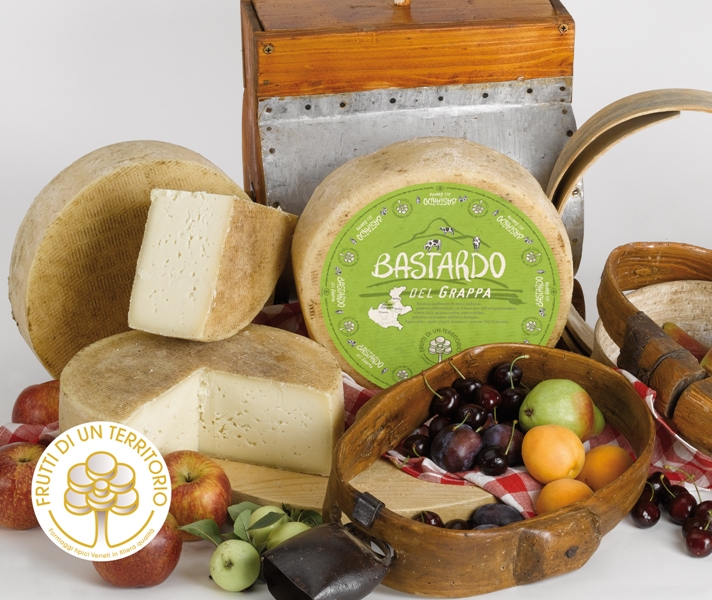 Cheesemaking was once widespread all over the Pedemontana area around Mount Grappa, especially at the start of spring when many would climb the slopes of the Massiccio foothills with their cattle herds to make the best use of the natural resources available in the mountains. Cheese production in 'malga' (mountain huts) was in fact very simple, as it was not carried out by professional cheesemakers, but techniques were passed down from father to son, based on the knowledge and ‘tricks of the trade’ learnt through experience. In general the most widely produced cheese in the Pedemontana hills was Morlacco, but when the environmental conditions and the changes in the grass of the pastures due to the advancing season brought changes to the main ingredient, the dairyman had to produce a different cheese, taking his inspiration from the techniques used to make the Asiago d’Allevo or Montasio varieties. Due to its recipe not being traceable to either of these two types, this cheese was known as Bastardo, a hybrid of past experience and various dairy techniques. Another reason for its name was that the quantity of goat’s milk was added to the milk used in its production. It was in fact not unusual to observe the cows in the mountain pastures accompanied by a few goats, whose milk was insufficient to be used on its own and was therefore added to the cows’ milk. The tradition of the mountain refuges is that the milk collected in the evening should be left to rest in the cool overnight. The fat is then separated off during the skimming process and the milk is poured into a large copper pot and then mixed with the fresh morning milk. The mixture is then heated, while being kept in constant motion then brought to a temperature of between 38 and 42° C. At this point the rennet is added and then the rennet is delicately broken into pieces and then heated further to a temperature of 45 degrees. The rennet is then poured into wooden moulds and a light pressure is exerted on it, continuing the discharge for 24 hours. It is then time to remove the moulds and let the cheese rest, in the “cason del fogo” for 2-3 days, until the cheese takes on a soft consistency. The salting process takes place in brine, for a duration of no longer than 4-5 days so that the delicate and lightly aromatic taste is not altered. This is followed by maturation in a suitable place for a minimum of four months. Today’s cheese production has maintained the art of the old traditional techniques and combined them with modern procedures.
Cheesemaking was once widespread all over the Pedemontana area around Mount Grappa, especially at the start of spring when many would climb the slopes of the Massiccio foothills with their cattle herds to make the best use of the natural resources available in the mountains. Cheese production in 'malga' (mountain huts) was in fact very simple, as it was not carried out by professional cheesemakers, but techniques were passed down from father to son, based on the knowledge and ‘tricks of the trade’ learnt through experience. In general the most widely produced cheese in the Pedemontana hills was Morlacco, but when the environmental conditions and the changes in the grass of the pastures due to the advancing season brought changes to the main ingredient, the dairyman had to produce a different cheese, taking his inspiration from the techniques used to make the Asiago d’Allevo or Montasio varieties. Due to its recipe not being traceable to either of these two types, this cheese was known as Bastardo, a hybrid of past experience and various dairy techniques. Another reason for its name was that the quantity of goat’s milk was added to the milk used in its production. It was in fact not unusual to observe the cows in the mountain pastures accompanied by a few goats, whose milk was insufficient to be used on its own and was therefore added to the cows’ milk. The tradition of the mountain refuges is that the milk collected in the evening should be left to rest in the cool overnight. The fat is then separated off during the skimming process and the milk is poured into a large copper pot and then mixed with the fresh morning milk. The mixture is then heated, while being kept in constant motion then brought to a temperature of between 38 and 42° C. At this point the rennet is added and then the rennet is delicately broken into pieces and then heated further to a temperature of 45 degrees. The rennet is then poured into wooden moulds and a light pressure is exerted on it, continuing the discharge for 24 hours. It is then time to remove the moulds and let the cheese rest, in the “cason del fogo” for 2-3 days, until the cheese takes on a soft consistency. The salting process takes place in brine, for a duration of no longer than 4-5 days so that the delicate and lightly aromatic taste is not altered. This is followed by maturation in a suitable place for a minimum of four months. Today’s cheese production has maintained the art of the old traditional techniques and combined them with modern procedures.
Bastardo del Grappa is a table cheese typical of the Mount Grappa region with semi-cooked texture made from cow’s milk. Light to yellow coloured dough, with scattered small holes and a thick and rough rind it has an intense flavour, pleasant and never spicy.
